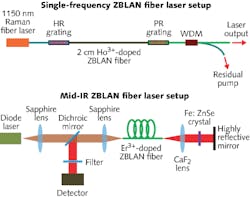FIBER LASERS: ZBLAN fiber lasers span visible to mid-IR range
Using rare-earth-doped zirconium fluoride/barium fluoride/lanthanum fluoride/aluminum fluoride/sodium fluoride (ZrF4-BaF2-LaF3-AlF3-NaF, or ZBLAN) optical fibers, researchers at NP Photonics (Tucson, AZ), the University of Arizona (Tucson, AZ), and NASA Langley Research Center (Hampton, VA) have developed the first single-frequency ZBLAN fiber laser operating at 1200 nm (with frequency-doubling capability to 600 nm), while a smaller subset of the research team from the University of Arizona has demonstrated a continuous-wave (CW) modelocked mid-infrared (mid-IR) ZBLAN fiber laser operating at 2.8 μm.1, 2 While the required optical components and pumping schemes differed greatly for the two laser types, both used ZBLAN-based optical fiber, demonstrating the broad-wavelength-range capabilities of this rare-earth-doped fiber-laser technology (see figure).
Single-frequency ZBLAN fiber laser
Fiber lasers in the 1200 nm window are typically Raman fiber lasers, created by pumping a Raman fiber with a 1-μm-emitting ytterbium (Yb)-doped silica fiber laser; unfortunately, they suffer from high-threshold, high-intensity noise, and a broad spectrum. An alternative to these designs takes advantage of the small phonon energy and long radiative lifetimes of ZBLAN fibers; specifically, holmium (Ho3+)-doped ZBLAN fibers can be used to output a 1200 nm signal when pumped at their strong absorption wavelength of 1150 nm—a wavelength easily achieved with semiconductor or Raman fiber lasers.
Using a heavily Ho3+-doped ZBLAN fiber, the researchers created a single-frequency 1200 nm output by end-pumping the fiber with a 1150 nm Raman fiber laser that was spliced in as the input to a narrow-bandwidth cascade of high-reflection (HR) and polarization-maintaining partial-reflection (PR) fiber Bragg gratings to ensure single-longitudinal-mode (single-frequency) and single-polarization output.
A polarization-maintaining, wavelength-division-multiplexing (WDM) coupler removes the pump light and also maintains single-polarization output. This single-frequency, distributed Bragg reflector (DBR)-based fiber laser has a 10 mW output (with 520 mW pump power) and a less than 100 kHz linewidth; the team is working on increasing the current 3.8% efficiency by optimizing the doping level, reducing fiber contaminants, and reducing cavity losses through improved assembly procedures.
According to the research team, this is the first single-frequency 1200 nm fiber laser that has been developed. Such single-frequency lasers have applications in sensing, as pump lasers, and in a host of biomedical applications, and can also be frequency-doubled to develop visible-light fiber lasers used as guidestar lasers.
Modelocked mid-IR ZBLAN fiber laser
Ultrafast modelocked fiber lasers are used in materials processing, imaging, spectroscopy, and nonlinear frequency conversion. To date, modelocked IR fiber lasers are typically limited to the 1.0, 1.5, and 2.0 μm regions due to limitations in strong rare-earth transitions in silica-based glasses. But because ZBLAN has a low phonon energy and high transparency in the UV through IR wavelength regions, it can achieve lasing even out to the mid-IR region, enabling such applications as IR countermeasures and laser surgery.
To fabricate the 2.8 μm laser, a focused 976 nm diode laser pumps a section of Er3+-doped ZBLAN fiber, followed by an iron/zinc-selenide (Fe2+:ZnSe)-based crystal that serves as the saturable absorber for CW modelocked operation. Stable CW modelocked output with an average power of 51.4 mW was obtained and 19 ps pulses with 1 nJ energy were produced at 2.78 μm.
“ZBLAN fibers have been around for more than 30 years and rare-earth-doped ZBLAN fiber lasers have been demonstrated at wavelength ranges from the UV to mid-IR,” says Xiushan Zhu, assistant research professor at the University of Arizona. “Nevertheless, ZBLAN fibers still have great potential for novel fiber laser development. Our recent accomplishment highlights the exciting prospect that wavelength coverage of single-frequency fiber lasers and modelocked fiber lasers can be expanded significantly by using rare-earth-doped ZBLAN fibers.”
REFERENCES
1. X. Zhu et al., Opt. Lett., 37, 20, 4185 (Oct. 15, 2012).
2. C. Wei et al., Opt. Lett., 37, 18, 3849 (Sept. 15, 2012).
About the Author

Gail Overton
Senior Editor (2004-2020)
Gail has more than 30 years of engineering, marketing, product management, and editorial experience in the photonics and optical communications industry. Before joining the staff at Laser Focus World in 2004, she held many product management and product marketing roles in the fiber-optics industry, most notably at Hughes (El Segundo, CA), GTE Labs (Waltham, MA), Corning (Corning, NY), Photon Kinetics (Beaverton, OR), and Newport Corporation (Irvine, CA). During her marketing career, Gail published articles in WDM Solutions and Sensors magazine and traveled internationally to conduct product and sales training. Gail received her BS degree in physics, with an emphasis in optics, from San Diego State University in San Diego, CA in May 1986.
